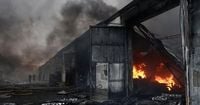Russia has unleashed a fresh wave of attacks on Ukraine’s power grid and civilian infrastructure, intensifying a campaign that has left millions bracing for another bitter winter of blackouts and hardship. The strikes, which began overnight on October 11 and continued through October 13, 2025, targeted key regions including Kyiv, Donetsk, Odesa, and Chernihiv, and resulted in injuries, deaths, and widespread power outages, according to reports from the Associated Press and RFE/RL.
Ukraine’s largest private energy company, DTEK, was hit particularly hard, with two employees wounded during a strike on a substation, Kyiv regional Governor Mykola Kalashnyk confirmed. The country’s Energy Ministry reported that infrastructure in Donetsk, Odesa, and Chernihiv was also damaged. The attacks triggered emergency power cuts across seven regions—Kharkiv, Sumy, Poltava, Donetsk, Dnipropetrovsk, Zaporizhzhya, and Kirovohrad—leaving industrial consumers and civilians alike in the dark.
President Volodymyr Zelenskyy, in a series of urgent messages on X (formerly Twitter), described the situation as “aerial terror against our cities and communities,” noting that Russia had launched “more than 3,100 drones, 92 missiles, and around 1,360 glide bombs” in the past week alone. He called for tighter secondary sanctions on buyers of Russian oil, emphasizing, “Sanctions, tariffs, and joint actions against the buyers of Russian oil — those who finance this war — must all remain on the table.”
These attacks are part of a broader Russian strategy to erode Ukrainian morale and cripple the country’s economy and energy sector before the onset of winter. As outlined in Espreso TV, Russian President Vladimir Putin aims to create “unbearable living conditions” in Ukraine, hoping to force surrender by making daily life impossible. The strikes have become more systematic, targeting not only power plants but also gas fields, and are reminiscent of the “anxious and dark winter of the first year of the great war.”
Yet, history offers little support for Putin’s belief that bombing cities will lead to capitulation. As journalist Vitaly Portnikov observed in his Espreso TV column, “History has never seen cases where bombing cities led to a total desire to capitulate, but Putin doesn’t take this into account—no matter what history and the experience of this war indicate to the contrary.” Instead, he argues, the real motivation may be to destroy Ukraine’s economic prospects and demographically weaken the country, a tactic with deep roots in Moscow’s imperial past.
Ukraine, however, has not remained passive. In a dramatic counterstrike, Ukrainian drones targeted a fuel depot in Russian-occupied Feodosia, Crimea, overnight on October 12-13, causing a massive fire visible from kilometers away. Crimean authorities claimed over 20 drones were shot down and reported no casualties, but Ukraine’s intelligence service confirmed that at least five reservoirs at the facility were hit, sparking the blaze. This attack follows a series of Ukrainian drone strikes on Russian military facilities and oil refineries, which, according to Espreso TV, have already forced Russia to “lose a significant portion of its refining capacity,” raising the cost and complexity of the war for Moscow.
The tit-for-tat escalations have drawn in international actors, notably the United States. According to the Financial Times and The Wall Street Journal, the U.S. has been sharing intelligence with Kyiv for months to facilitate Ukrainian strikes on energy facilities deep inside Russia. This cooperation, which intensified since midsummer 2025, includes sharing information on route planning, altitude, timing, and mission decisions, as well as identifying target vulnerabilities. The Trump administration reportedly approved such intelligence sharing as early as July 2025, following a phone call between President Trump and President Zelenskyy.
Yet, the U.S. role remains a subject of intense debate and diplomatic maneuvering. While Trump suggested on October 6 that he may send long-range Tomahawk missiles to Ukraine if the war is not “settled” soon, he has also stated that he has “sort of made a decision” on the matter. In an interview with Fox News, Zelenskyy commented, “We work on it. And I’m waiting for president to yes. Of course we count on such decisions, but we will see. We will see.”
The prospect of the U.S. providing Tomahawk missiles to Ukraine has alarmed Moscow. Kremlin spokesperson Dmitry Peskov called the issue “of extreme concern,” warning that such a move would mark a “new stage of escalation” in both the conflict and U.S.-Russia relations. Russian President Putin has echoed these sentiments, while Belarusian President Alexander Lukashenko expressed skepticism that the U.S. would actually deliver the missiles, remarking, “I think we need to calm down in this regard. Our friend Donald … sometimes he takes a more forceful approach, and then, his tactic is to let go a little and step back. Therefore, we shouldn’t take this literally, as if it’s going to fly tomorrow.”
Meanwhile, the humanitarian toll continues to mount. On October 13, Russian air strikes caused a massive fire in Odesa, engulfing more than 5,000 square meters of warehouse space and injuring one person. At least three people were killed in drone strikes on Zaporizhzhya and Chernihiv, according to Ukrainian emergency services. The attacks have left families grieving and communities struggling to cope with the destruction of vital infrastructure.
The international community is watching closely. European Union foreign policy chief Kaja Kallas visited Kyiv on October 13 for high-level talks focused on financial and military support, as well as the security of Ukraine’s energy sector. Kallas praised the courage of Ukrainians and warned, “Every time a Russian drone or plane violates our airspace, there is a risk of escalation, unintended or not. Russia is gambling with war.” She called on Europe to strengthen its defense capabilities and hold Russia accountable for its actions.
As winter approaches, Ukraine’s resilience is once again being tested. The struggle for control over energy infrastructure has become a central front in the war, with both sides seeking to sap each other’s strength and will. For Ukrainians, the coming months promise more hardship, but also a determination to endure—and, if possible, to knock out some of the dragon’s teeth.


